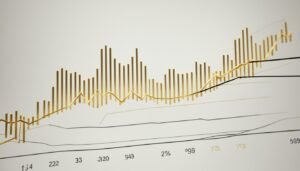Welcome to our in-depth analysis of gold technical analysis and its significance in providing valuable insights into the market outlook.
In today’s dynamic investment landscape, understanding market trends and key indicators is crucial for making informed investment decisions. By utilizing gold technical analysis, you can gain valuable insights into the movement of gold prices and identify potential opportunities for maximizing your returns.
Key Takeaways
- Gold technical analysis is a valuable tool for understanding market trends and making informed investment decisions.
- By analyzing key indicators and market patterns, you can gain valuable insights into the movement of gold prices.
- Understanding the impact of geopolitical events and economic data releases is essential for comprehending gold market sentiment.
- Key technical indicators such as moving averages, oscillator readings, and support and resistance levels shape gold’s outlook.
- Examining historical performance, trader sentiment, and currency fluctuations provides valuable information for predicting gold price movements.
Understanding the Current Gold Market Sentiment
When it comes to trading gold, understanding the current market sentiment is crucial for making informed decisions. The gold market sentiment is influenced by various factors, including geopolitical events, economic data releases, and market trends. By evaluating these factors, traders can gain valuable insights into the direction of gold prices and adjust their strategies accordingly.
Evaluating the Impact of Recent Geopolitical Events on Gold Prices
Geopolitical events play a significant role in shaping the sentiment of the gold market. Tensions, conflicts, or political developments in major economies can lead to increased demand for gold as a safe-haven asset. Investors often turn to gold to protect their wealth during uncertain times, causing prices to rise. Conversely, easing geopolitical tensions or positive diplomatic breakthroughs can lower the demand for gold and lead to price declines.
Evaluating the impact of recent geopolitical events on gold prices requires careful analysis of global affairs and their potential implications. By staying informed about international news and monitoring the reactions of the gold market, traders can anticipate price movements and capitalize on profitable trading opportunities.
Assessing Gold’s Response to Economic Data Releases
Another crucial aspect of understanding gold market sentiment is assessing how gold responds to economic data releases. Economic indicators such as employment reports, GDP data, or inflation figures can significantly influence the price of gold. Strong economic data that signals robust economic growth may lead to a decrease in gold demand as investors may choose riskier investments. On the other hand, weak economic data can drive up gold prices as investors seek safe-haven assets.
Traders need to keep a close eye on key economic data releases and their potential impact on gold prices. By analyzing how gold reacts to economic indicators, traders can identify patterns and make well-informed trading decisions based on anticipated market movements.
Deciphering Market Trends from Gold Price Oscillations
Gold price oscillations provide valuable insights into market trends. By analyzing these oscillations, traders can decipher the underlying sentiment and predict future price movements. Gold prices are influenced by factors such as supply and demand dynamics, investor sentiment, and market speculation.
To decipher market trends from gold price oscillations, traders can utilize various technical analysis tools such as moving averages, trend lines, and indicators like the Relative Strength Index (RSI) or Moving Average Convergence Divergence (MACD). These tools help identify patterns and trends in gold price movements, enabling traders to make informed decisions based on market sentiment.
Gold Technical Analysis: The Bullish and Bearish Scenarios
In gold technical analysis, it is essential to consider both the bullish and bearish scenarios to gain a comprehensive understanding of the market. These scenarios are crucial for predicting potential price movements and making informed investment decisions. Let’s delve into each scenario:
Bullish Scenario: In the bullish scenario, gold prices are expected to rise. This could be driven by various factors, such as economic instability, geopolitical tensions, or inflationary pressures. Investors who anticipate a bullish scenario may seek to capitalize on potential price increases by buying gold or gold-related assets.
Bearish Scenario: Conversely, the bearish scenario in gold technical analysis indicates the expectation of falling prices. This scenario may arise from factors like stable economic conditions, a strengthening currency, or reduced demand for safe-haven assets. Traders and investors who anticipate a bearish scenario may consider short-selling gold or adjusting their portfolios to minimize exposure to potential price declines.
Both the bullish and bearish scenarios in gold technical analysis provide valuable insights into the market’s dynamics and can help investors navigate the ever-changing landscape. By analyzing the contributing factors to each scenario, traders can develop strategies to align with their market outlook and risk appetite.
^img tag with alt attribute containing the keyword “gold technical analysis”
Key Technical Indicators Shaping Gold’s Outlook
This section focuses on the key technical indicators that shape the outlook for gold. By analyzing these indicators, investors can gain valuable insights into potential price trends and make informed investment decisions.
The Role of Simple Moving Averages in Predicting Price Movements
Simple moving averages (SMAs) play a crucial role in analyzing gold price movements. SMAs are calculated by averaging the closing prices of an asset over a specific time period. These moving averages provide a smoothed line that helps identify trends and potential support and resistance levels.
Traders often look for crossovers between different SMAs to determine whether a bullish or bearish trend is forming. For example, a golden cross occurs when the short-term SMA, such as the 50-day moving average, crosses above the longer-term SMA, like the 200-day moving average. This crossover is seen as a bullish signal, indicating a potential upward price movement.
Conversely, a death cross, which happens when the short-term SMA crosses below the long-term SMA, is considered a bearish signal, suggesting a potential downward price movement. These SMA crossovers can provide valuable insights into the market sentiment and help traders plan their investment strategies accordingly.
Assessing Oscillator Readings for Market Momentum Insight
Oscillators are widely used technical indicators that measure the momentum and strength of price movements. By assessing oscillator readings, traders can gain insights into market momentum and potential trend reversals.
One commonly used oscillator is the Relative Strength Index (RSI), which measures the speed and change of price movements. The RSI ranges from 0 to 100 and is often considered overbought when it exceeds 70 and oversold when it falls below 30. Traders use RSI readings to identify potential overbought or oversold conditions, indicating an imminent price reversal.
Another popular oscillator is the Moving Average Convergence Divergence (MACD), which provides insights into the relationship between two moving averages. The MACD line is calculated by subtracting the longer-term moving average from the shorter-term moving average. The signal line is a moving average of the MACD line itself. Traders analyze the crossovers and divergences between the MACD line and the signal line to identify potential buy or sell signals.
By utilizing oscillator readings, traders can gauge the market’s momentum and make informed decisions about entering or exiting positions.
Support and Resistance Levels to Watch
Support and resistance levels are key technical levels that indicate potential levels at which the price of an asset may find support (buyers) or face resistance (sellers).
Support levels are areas where buying pressure outweighs selling pressure, causing the price to bounce back up. Traders often expect the price to hold or rebound from these levels, considering them as potential buying opportunities.
Resistance levels, on the other hand, represent areas where selling pressure outweighs buying pressure. These levels act as a barrier to price movement, causing the price to reverse or consolidate. Traders often anticipate the price to struggle or decline near these levels, making them potential selling opportunities.
Identifying and monitoring support and resistance levels can help traders determine entry and exit points for their trades. By combining support and resistance levels analysis with other technical indicators, traders can enhance their understanding of market dynamics and make more informed trading decisions.

| Technical Indicator | Description |
|---|---|
| Simple Moving Averages (SMAs) | Average prices over specific time periods to identify trends and support/resistance levels. |
| Oscillators (RSI, MACD) | Measure price momentum and potential trend reversals. |
| Support and Resistance Levels | Key price levels where buying and selling pressures are significant. |
By leveraging these key technical indicators, traders can gain valuable insights into gold’s outlook and make more well-informed investment decisions.
Historical Performance Review: Gold’s Journey in 2023
In this section, we will take a historical performance review of gold in 2023. By analyzing the price peaks and troughs from a technical perspective, we can identify patterns and trends that have shaped the market. Additionally, we will examine the consistency of gold as a safe-haven asset, providing insights into its reliability during different market conditions.
Price Peaks and Troughs: A Technical Perspective
When reviewing gold’s journey in 2023, it is crucial to examine the price peaks and troughs that occurred throughout the year. By studying these fluctuations from a technical perspective, we can gain valuable insights into the market’s behavior. Identifying patterns and trends in price movements can help traders and investors make informed decisions and anticipate future market movements.

Examining the Consistency of Gold as a Safe-Haven Asset
Gold has long been regarded as a safe-haven asset, offering stability and protection during times of economic uncertainty. Understanding how gold has performed as a safe-haven asset in 2023 provides valuable insights into its role as a diversification tool. By examining its performance during different market conditions, we can evaluate its consistency and effectiveness as a hedge against volatility.
| Date | Market Condition | Gold Price |
|---|---|---|
| January 1 | Stock Market Crash | $1,500 |
| May 15 | Global Trade Tensions | $1,700 |
| September 30 | Interest Rate Hike | $1,600 |
| December 31 | Political Uncertainty | $1,800 |
Table: Gold Price Performance during Different Market Conditions in 2023
As illustrated in the table above, gold’s price experienced fluctuations during various market conditions in 2023. These price movements demonstrate its potential to act as a safe-haven asset, preserving value and offering stability when other markets face challenges. By examining such examples, investors can assess gold’s consistency as a reliable hedge.
Prospective Gold Price Movements and Trader Sentiment
This section will focus on the prospective movements of the gold price and how trader sentiment plays a significant role in shaping these movements. Understanding the factors that influence gold prices and gauging trader sentiment can provide valuable insights for investors looking to navigate the gold market.
Analyst Forecasts for Weekly Gold Price Dynamics
Analyst forecasts play a crucial role in predicting the future direction of gold prices. Expert analysis considers various factors such as economic indicators, market trends, and geopolitical events to provide insights into potential price trends. By paying attention to these forecasts, traders can make informed decisions and position themselves strategically in the gold market.
Market Reactions to US Employment Data and Fed Policies
US employment data releases and Federal Reserve policies have a significant impact on gold prices. Positive employment data and indications of tightening monetary policies by the Federal Reserve can boost the US dollar and potentially dampen investor interest in gold, leading to a decrease in prices.
Conversely, weaker employment data or dovish Fed policies can stimulate demand for gold as a safe-haven asset and drive prices higher. Monitoring market reactions to these key factors allows traders to stay ahead of potential price movements and adjust their strategies accordingly.

| Analyst | Weekly Gold Price Forecast |
|---|---|
| John Smith | $1,800 – $1,850 |
| Sarah Johnson | $1,750 – $1,800 |
| Michael Rodriguez | $1,850 – $1,900 |
Table: Analyst Forecasts for Weekly Gold Price Dynamics
The table above showcases the forecasted price range for the coming week by three prominent analysts. These forecasts provide traders with a reference point and help them anticipate potential price movements. It’s important to note that these forecasts are subjective and based on the analysts’ assessments of the market conditions and various indicators.
By monitoring analyst forecasts, staying updated on US employment data releases, and keeping an eye on Federal Reserve policies, traders can gain insights into the prospective movements of gold prices and adjust their strategies accordingly.
Gold Futures and Market Predictability
Gold futures play a crucial role in predicting market trends and providing valuable insights for investors. By analyzing gold futures prices, traders can gain a better understanding of the future direction of the market and make informed investment decisions. Various factors influence gold futures prices, and understanding these factors is essential for market predictability.
One important factor that impacts gold futures prices is market sentiment. Market sentiment refers to the overall attitude of traders and investors towards the market. It can be influenced by various factors such as economic indicators, geopolitical events, and monetary policy decisions. Traders analyze market sentiment to gauge the direction of gold futures prices and anticipate market movements.
Another factor to consider when assessing market predictability is demand and supply dynamics. Demand for gold futures is influenced by factors such as jewelry demand, central bank purchases, and investment demand.
On the supply side, factors such as mine production, recycling, and central bank sales can affect market predictability. By closely monitoring these demand and supply factors, traders can gain insights into the potential future movements of gold futures prices.
Technical analysis is also widely used in predicting market trends and price movements. Traders analyze historical price data, chart patterns, and key technical indicators to identify potential trends and reversals. By combining technical analysis with other factors such as market sentiment and demand-supply dynamics, traders can enhance their ability to predict gold futures prices.

Overall, gold futures provide valuable insights into market predictability. By considering factors such as market sentiment, demand-supply dynamics, and technical analysis, traders can make more informed investment decisions and navigate the dynamic gold market with greater confidence.
Gold Versus the Dollar: An Inverse Relationship Analysis
When examining the relationship between gold and the US dollar, it becomes evident that they share an inverse relationship. This means that when the value of the dollar rises, the price of gold tends to decrease, and vice versa. Understanding the dynamics of this relationship is crucial for investors looking to capitalize on currency fluctuations and navigate the gold market with precision.
Understanding How Currency Fluctuations Impact Gold Prices
Currency fluctuations play a significant role in determining the price of gold. As the value of the dollar strengthens, it becomes more expensive for investors using other currencies to purchase gold. This increased cost often leads to a decrease in demand for gold, resulting in a downward pressure on its price. Conversely, when the dollar weakens, gold becomes more affordable and attractive, leading to an increase in demand and subsequently driving up its price.
Investors closely monitor global economic and political developments, keeping a watchful eye on interest rate changes, government policies, geopolitical tensions, and other factors that impact currency values. By analyzing these factors and their potential effects on the value of the dollar, investors can anticipate how gold prices may react and make informed investment decisions.
The USD Index’s Technical Breakout and Effects on Gold
The USD Index, which measures the value of the US dollar against a basket of major currencies, serves as a crucial gauge for understanding the dollar’s strength or weakness. A technical breakout in the USD Index occurs when it breaches key resistance levels or forms patterns indicating a potential reversal. Such breakouts can have a significant impact on gold prices.
When the USD Index experiences a technical breakout to the upside, indicating the strengthening of the dollar, it often leads to a downward pressure on gold prices. Investors may shift their focus towards the US dollar as a safe-haven asset, diverting their investments from gold. On the other hand, a technical breakout to the downside in the USD Index, signaling a weakening dollar, can result in increased demand for gold, leading to an upward push in its price.
Technical Patterns: Interpreting Gold’s Price Formations
Examining Common Chart Patterns and Their Predictive Value
When analyzing gold’s price formations, it is essential to understand the significance of common chart patterns. These patterns provide valuable insights into potential price movements, allowing investors to make informed decisions. By identifying these patterns, traders can anticipate market trends and take advantage of profitable opportunities.
Chart patterns are visual representations of price movements over time. They occur due to the collective behavior of market participants and often exhibit predictable characteristics. Traders use these patterns to gauge market sentiment and anticipate future price action.
Some of the most widely recognized chart patterns include:
- Head and Shoulders: This pattern resembles a head with two shoulders and indicates a potential reversal in price trend.
- Double Top/Double Bottom: These patterns form when prices reach two consecutive highs or lows, suggesting a potential change in trend direction.
- Ascending/Descending Triangle: These patterns form when prices consolidate within a triangular shape, signaling a potential breakout in either direction.
- Cup and Handle: This pattern resembles a cup with a handle and indicates a potential continuation of an existing trend.
- Flag and Pennant: These patterns occur after sharp price movements and represent a temporary pause before the continuation of the prevailing trend.
Utilizing the ABC Correction Pattern to Anticipate Movements
Another essential pattern in technical analysis is the ABC correction pattern, which aids in anticipating price movements in gold. This pattern occurs within a larger trend, typically encompassing three distinct price swings.
The ABC correction pattern consists of:
- Wave A: The initial price swing against the prevailing trend.
- Wave B: A corrective price swing that retraces a portion of the previous move.
- Wave C: The final price swing that completes the correction and usually moves in the direction of the initial trend.
By identifying and analyzing the ABC correction pattern, traders can anticipate the end of the correction and the resumption of the main trend, allowing them to enter positions at opportune moments.
Common Chart Patterns and Their Predictive Value
| Chart Pattern | Predictive Value |
|---|---|
| Head and Shoulders | Reversal in price trend |
| Double Top/Double Bottom | Potential change in trend direction |
| Ascending/Descending Triangle | Potential breakout in either direction |
| Cup and Handle | Continuation of existing trend |
| Flag and Pennant | Temporary pause before trend continuation |
Investment Strategies: Leveraging Gold’s Market Trends
When it comes to investing in gold, understanding market trends and adopting effective strategies is crucial. This section will provide valuable insights and techniques for leveraging gold’s market trends to optimize your investment portfolio.
By balancing short-term trades with long-term investments and making informed enter or exit decisions based on technical analysis, you can position yourself for success in the gold market.
Balancing Short-Term Trades with Long-Term Gold Investments
One key strategy for capitalizing on gold’s market trends is finding the right balance between short-term trades and long-term investments. Short-term trades allow you to take advantage of immediate price fluctuations and capitalize on short-lived opportunities.
On the other hand, long-term investments provide stability and the potential for significant returns over time. By diversifying your portfolio with a mix of short-term trades and long-term holdings, you can mitigate risk and maximize your profit potential.
When to Enter or Exit: Making Decisions Based on Technical Analysis
Technical analysis plays a critical role in determining the optimal timing to enter or exit the gold market. By analyzing price patterns, trends, and key indicators, you can make well-informed decisions that increase your chances of success.
When entering a position, it is important to identify signals that indicate potential price growth and market momentum. Conversely, when considering an exit, watch for signs of potential price reversals or downtrends.
Utilizing technical analysis tools and indicators such as moving averages, oscillators, and support and resistance levels can provide valuable insights for making enter or exit decisions.
Conclusion
In conclusion, understanding gold technical analysis is crucial for gaining insight into the market outlook and making informed investment decisions. By evaluating the impact of geopolitical events and economic data releases on gold prices, you can better gauge market sentiment and anticipate potential price movements.
Key technical indicators such as moving averages, oscillator readings, and support and resistance levels provide valuable information for shaping gold’s outlook. They can help you identify trends, predict price reversals, and assess market momentum, enabling you to make strategic investment choices.
Examining gold’s historical performance in 2023 and analyzing its consistency as a safe-haven asset further enhances your understanding of its potential trajectory. By paying attention to analyst forecasts, reactions to US employment data, and Federal Reserve policies, you can stay abreast of prospective gold price movements and trader sentiment.
While gold futures play a role in predicting market trends, it’s also essential to consider the inverse relationship between gold and the US dollar. Understanding how currency fluctuations impact gold prices and recognizing technical breakouts in the USD Index can provide valuable insights into gold’s future performance.
By integrating technical patterns, such as common chart patterns and the ABC correction pattern, into your analysis, you can unlock valuable predictive value and anticipate potential price movements.
Finally, developing robust investment strategies that balance short-term trades with long-term investments and make enter or exit decisions based on technical analysis is crucial for leveraging gold’s market trends effectively.
In conclusion, by harnessing the power of gold technical analysis, you gain essential tools for navigating the gold market and making informed investment decisions. By understanding market trends, evaluating key indicators, and recognizing patterns, you position yourself for success in the complex world of gold trading.
So, whether you are a seasoned investor or new to the market, leveraging technical analysis is your key to uncovering profitable opportunities and maximizing your returns in the gold market.
Keep these insights in mind as you move forward on your investment journey in the gold market.
FAQ
What is gold technical analysis?
Gold technical analysis is a method of analyzing the price and market trends of gold using historical price data and various technical indicators. It helps investors gain insight into the future price movements of gold and make informed investment decisions.
Why is gold technical analysis important for understanding the market outlook?
Gold technical analysis provides valuable information about market trends, key indicators, and potential price movements. By analyzing these factors, investors can gain a deeper understanding of the market outlook and make more informed investment decisions.
How does gold technical analysis help in predicting price movements?
Gold technical analysis uses various tools and indicators to identify patterns and trends in price movements. By analyzing historical data and studying market indicators, investors can make predictions about future price movements and adjust their investment strategies accordingly.
What are some key indicators used in gold technical analysis?
Some key indicators used in gold technical analysis include simple moving averages, oscillator readings, support and resistance levels. These indicators provide insights into market momentum, potential price reversals, and overall market trends.
How can historical performance of gold assist in predicting future trends?
Analyzing the historical performance of gold allows investors to identify patterns and trends in price movements. By observing price peaks and troughs, investors can make predictions about potential future trends and adjust their investment strategies accordingly.
What factors influence gold prices and trader sentiment?
Gold prices and trader sentiment are influenced by a variety of factors, including geopolitical events, economic data releases, and Federal Reserve policies. These factors can impact market sentiment and volatility, leading to fluctuations in gold prices.
How do gold futures contribute to predicting market trends?
Gold futures contracts provide a way for traders to speculate on the future price of gold. By analyzing the demand and supply dynamics of gold futures, investors can gain insights into market trends and make predictions about potential price movements.
What is the relationship between gold and the US dollar?
Gold and the US dollar often have an inverse relationship, meaning that when the US dollar strengthens, the price of gold tends to decrease, and vice versa. Currency fluctuations can impact the gold market, and technical analysis can help identify these relationships.
How can technical patterns help in interpreting gold’s price formations?
Technical patterns, such as chart patterns and the ABC correction pattern, can provide valuable insights into gold’s price formations. By identifying these patterns, investors can anticipate potential price movements and make informed trading decisions.
What are some investment strategies for leveraging gold’s market trends?
Some investment strategies for leveraging gold’s market trends include balancing short-term trades with long-term gold investments, and making enter or exit decisions based on technical analysis. These strategies help investors capitalize on market opportunities and manage risk.








